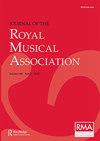达戈米日斯基管弦乐幻想曲中的讽刺、帝国与音阶
IF 0.5
2区 艺术学
0 MUSIC
引用次数: 0
摘要
摘要1863年,Alexander Dargomyzhsky策划了一个幽默幻想画廊,描绘居住在俄罗斯帝国西部边境的民族,包括波罗的海德国人、波兰人、乌克兰人和芬兰人。一方面,这个讽刺肖像画廊是吸引国内观众注意力的有效方式,因为波兰起义后,西方边境地区处于俄罗斯民众关注的前沿。另一方面,Dargomyzhsky一再重申他的意图,即幻想曲应该成为获得国际认可的一种手段,一年后,他实际上开始了在欧洲各地的宣传之旅。由此产生的三部幻想曲的帝国含义、Dargomyzhsky将其推向海外的尝试以及最后一部幻想曲《楚洪幻想曲》的作曲创造性,将Dargomyzhsky的管弦乐作品定位为俄罗斯19世纪音乐复杂的美学和文化谈判中的一个关键节点。本文章由计算机程序翻译,如有差异,请以英文原文为准。
Satire, Empire and Chromaticism in Dargomyzhsky’s Orchestral Fantasias
Abstract In 1863, Alexander Dargomyzhsky hatched plans for a gallery of humorous fantasias that would depict nationalities residing on the western border of the Russian Empire, including Baltic Germans, Poles, Ukrainians and Finns. On the one hand, this gallery of satirical portraits was an effective way of capturing the attention of domestic audiences, since the western borderlands were at the forefront of Russian popular attention in the wake of the Polish uprising. On the other hand, Dargomyzhsky repeatedly reiterated his intention that the fantasias should function as a means of achieving international recognition, and a year later he actually set off on a promotional tour across Europe. Together, the imperial implications of the three resulting fantasias, Dargomyzhsky’s attempts to market them abroad and the compositional inventiveness of the final fantasia, the Chukhon Fantasy, locate Dargomyzhsky’s orchestral oeuvre as a crucial node in the convoluted aesthetic and cultural negotiations of Russian nineteenth-century music.
求助全文
通过发布文献求助,成功后即可免费获取论文全文。
去求助
来源期刊
CiteScore
0.50
自引率
0.00%
发文量
16
期刊介绍:
The Journal of the Royal Musical Association was established in 1986 (replacing the Association"s Proceedings) and is now one of the major international refereed journals in its field. Its editorial policy is to publish outstanding articles in fields ranging from historical and critical musicology to theory and analysis, ethnomusicology, and popular music studies. The journal works to disseminate knowledge across the discipline and communicate specialist perspectives to a broad readership, while maintaining the highest scholarly standards.

 求助内容:
求助内容: 应助结果提醒方式:
应助结果提醒方式:


